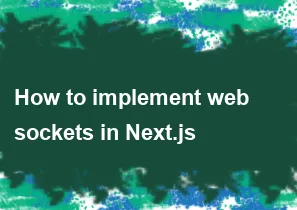How to implement web sockets in Next.js

In Next.js, you can implement WebSocket functionality using libraries such as socket.io or the native WebSocket API. Here, I'll guide you through implementing WebSocket communication in a Next.js project using socket.io. Make sure you have Node.js and npm installed on your machine.
Create a new Next.js project:
If you don't have a Next.js project yet, create one using the following commands:
bashnpx create-next-app my-next-app cd my-next-appInstall
socket.ioandsocket.io-client:Run the following commands to install the required packages:
bashnpm install socket.io socket.io-clientCreate a WebSocket server:
Create a new file named
server.jsin your project root. This file will serve as your WebSocket server.javascriptconst http = require('http'); const { Server } = require('socket.io'); const server = http.createServer(); const io = new Server(server, { cors: { origin: '*', }, }); io.on('connection', (socket) => { console.log('A user connected'); // Handle incoming messages socket.on('message', (data) => { console.log('Message from client:', data); // Broadcast the message to all connected clients io.emit('message', data); }); // Handle disconnection socket.on('disconnect', () => { console.log('A user disconnected'); }); }); const PORT = process.env.PORT || 3001; server.listen(PORT, () => { console.log(`Server listening on port ${PORT}`); });Modify
package.jsonto run the server:Update the
"scripts"section in yourpackage.jsonfile to include a script for running the WebSocket server:json"scripts": { "dev": "next dev", "build": "next build", "start": "next start", "server": "node server.js" }Run the WebSocket server:
Start the WebSocket server by running:
bashnpm run serverThis will run the WebSocket server on
http://localhost:3001.Implement WebSocket in your Next.js app:
Open the page where you want to use WebSocket communication, for example,
pages/index.js. Here's a simple example:javascriptimport { useEffect } from 'react'; import io from 'socket.io-client'; const Home = () => { useEffect(() => { const socket = io('http://localhost:3001'); // Handle incoming messages from the server socket.on('message', (data) => { console.log('Message from server:', data); }); // Clean up the socket connection on unmount return () => { socket.disconnect(); }; }, []); return ( <div> <h1>Next.js with WebSocket</h1> </div> ); }; export default Home;This example establishes a WebSocket connection when the component mounts, listens for incoming messages from the server, and disconnects when the component unmounts.
Run your Next.js app:
Start your Next.js app by running:
bashnpm run devVisit
http://localhost:3000in your browser, and you should see your app running with WebSocket communication.
That's it! You've successfully implemented WebSocket communication in a Next.js app using socket.io. Remember that this is a basic example, and you can customize it based on your specific requirements.
-
Popular Post
- How to optimize for Google's About This Result feature for local businesses
- How to implement multi-language support in an Express.js application
- How to handle and optimize for changes in mobile search behavior
- How to handle CORS in a Node.js application
- How to use Vue.js with a UI framework (e.g., Vuetify, Element UI)
- How to configure Laravel Telescope for monitoring and profiling API requests
- How to create a command-line tool using the Commander.js library in Node.js
- How to implement code splitting in a React.js application
- How to use the AWS SDK for Node.js to interact with various AWS services
- How to use the Node.js Stream API for efficient data processing
- How to implement a cookie parser middleware in Node.js
- How to implement WebSockets for real-time communication in React
-
Latest Post
- How to implement a dynamic form with dynamic field styling based on user input in Next.js
- How to create a custom hook for handling user interactions with the browser's device motion in Next.js
- How to create a custom hook for handling user interactions with the browser's battery status in Next.js
- How to implement a dynamic form with dynamic field visibility based on user input in Next.js
- How to implement a dynamic form with real-time collaboration features in Next.js
- How to create a custom hook for handling user interactions with the browser's media devices in Next.js
- How to use the useSWRInfinite hook for paginating data with a custom loading indicator in Next.js
- How to create a custom hook for handling user interactions with the browser's network status in Next.js
- How to create a custom hook for handling user interactions with the browser's location in Next.js
- How to implement a dynamic form with multi-language support in Next.js
- How to create a custom hook for handling user interactions with the browser's ambient light sensor in Next.js
- How to use the useHover hook for creating interactive image zoom effects in Next.js